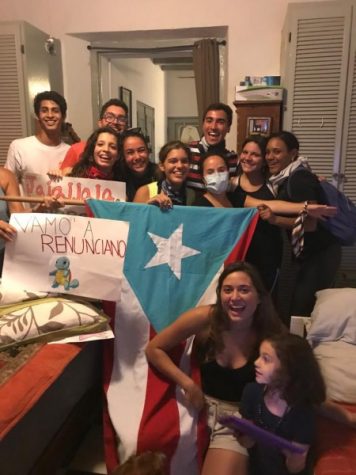Tulane student Clara Tomé reveals unforgettable experience in Puerto Rico
On the night of July 15, Tulane sophomore Clara Tomé witnessed the beginning of the protests in Puerto Rico that would eventually force Governor Ricardo Rosselló to resign from office. A protest that began as peaceful ended with police firing rubber bullets and tear gas into the crowd.
Tomé, who was on the third-floor balcony above the Puerto Rican citizens protesting in the streets, was able to feel the effects of the tear gas and was even barricaded inside the apartment she was in by the police.
When she could finally let down from her apartment, the police made her do everything they said.
“I remember one of the policemen told us that if we don’t walk on the sidewalk, they will shoot us. Even the chief of police said, ‘We’re not going to stop until the last drop of blood,’” Tomé said.

Talking to friends back in the U.S., Tomé realized the U.S. media was portraying the protests as much more violent than they actually were. Not only did they misrepresent the nature of the protests, but the media also misinterpreted the reason why the protests ensued.
The protests were commonly believed to have been primarily incited by leaked messages on Telegram between Rosselló and his cabinet mocking victims of Hurricane Maria and even Puerto Rican citizens themselves.
The protests, Tomé explained, were due not just to outrage over Rosselló’s leaked texts, but the decades of political corruption in Puerto Rico.
“I talked to some of my friends back in the United States who thought these protests started because of the chat, when in reality it was much more than that,” Tomé said, “It was due to decades of political corruption and the inability to act effectively towards Hurricane Maria and Irma.”
Though Tomé does believe it was twisted in American media, it still served to spread awareness of the political corruption being faced by the Puerto Rican people for decades now. People began to protest outside the White House to encourage President Donald Trump to comment on the state of the Puerto Rican government.
By July 19, artist Bad Bunny among other artists helped organize another protest. “I didn’t stay long, but I left by 6 p.m. because I was scared that it was going to get violent again.” Tomé remembers. Protesters began to fire off fireworks into the air, and the police responded by deploying tear gas into the air. These actions employed by the police led people to start questions if they went too far as numerous protesters were injured by rubber bullets and tear gas.
I just got tear gassed by police as they push protestors out of the area. Stay safe everyone. #RickyRenuncia @vicenews pic.twitter.com/gb9jaF3xxa
— aniucar (@AniUcar) July 23, 2019
One of the last and biggest protests took place on July 24 and consisted of a crowd of more than 500,000 people completely occupying the Luis Ferré Highway in San Juan. The American Civil Liberties Union reported that one-third of Puerto Rico’s population was estimated to be present at this protest.
“Workplaces all over the island stopped and went to protest on the major highways to stop people from passing because people not working will really halt the economy,” Tomé said.
Ricardo Rosselló stepped down from the position as governor two days after the Puerto Rican people shut down the economy by protesting through one of the major highways. His resignation was effective Aug. 2.
Other scandals were uncovered during the uproar of the protests. The Secretary of Education, Julia Keleher, laundered 12 million dollars and was responsible for closing more than 400 school in Puerto Rico. However, she was declared not guilty. Interestingly enough, Keleher is not even from Puerto Rico, but from Pennsylvania.
Political corruption has been conspicuous throughout Puerto Rico’s history, but the work of those fighting for change is beginning to pay off as Rosselló stepped down from his position.
As Tomé put it,“The protests helped get the existence of the Puerto Rican community out there.”
Your donation will support the student journalists of Tulane University. Your contribution will allow us to purchase equipment and cover our annual website hosting costs.


